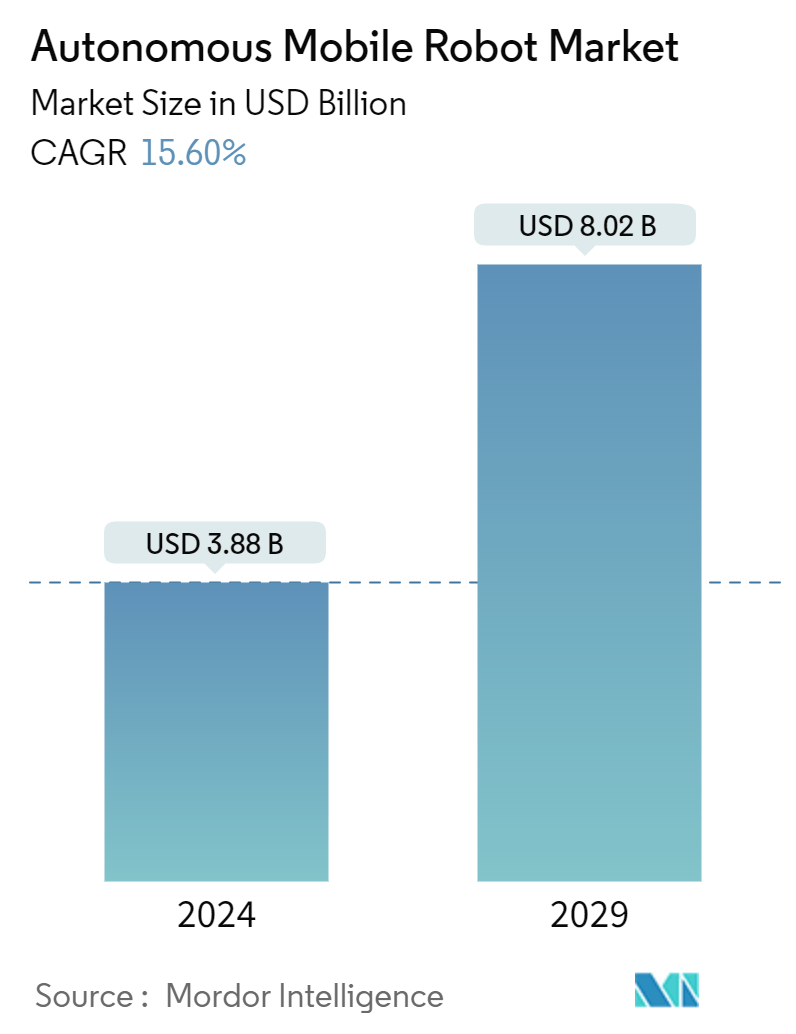Market Size of Autonomous Mobile Robot Industry

| Study Period | 2019 - 2029 |
| Market Size (2024) | USD 3.88 Billion |
| Market Size (2029) | USD 8.02 Billion |
| CAGR (2024 - 2029) | 15.60 % |
| Fastest Growing Market | Asia Pacific |
| Largest Market | Asia Pacific |
Major Players
*Disclaimer: Major Players sorted in no particular order |
Autonomous Mobile Robot Market Analysis
The Autonomous Mobile Robot Market size is estimated at USD 3.88 billion in 2024, and is expected to reach USD 8.02 billion by 2029, growing at a CAGR of 15.60% during the forecast period (2024-2029).
The Autonomous Mobile Robot Market size is estimated at USD 3.88 billion in 2024, and is expected to reach USD 8.02 billion by 2029, growing at a CAGR of 15.60% during the forecast period (2024-2029).
The increasing trends of automation in manufacturing, the growing e-commerce sector, the mass personalization of goods, and a shortage of low-cost labor are among the primary factors contributing to the market growth.
- The essential advantage of an AMR is its ability to understand its operating environment, enabling it to navigate around obstacles and operate safely in the presence of human operators. In contrast to an automated guided vehicle, which needs some form of guided paths, such as magnetic tape or QR codes, to navigate through its environment, an AMR can use data from cameras, laser scanners, and other sensors to understand its operating environment and make the decisions needed to move around it.
- Increasing robotics, autonomous technologies, and IoT advancements have created an ideal environment for adopting connected industrial autonomous vehicles across various industries. These autonomous vehicles are expected to change the industrial landscape alongside the steady adoption of autonomous technologies in consumer automotive vehicles and public transport. This rise of autonomous industrial cars is expected to drive the market's growth further in the future.
- Apart from labor-related challenges, safety is another critical factor in the shift toward leveraging AMRs for warehouse automation. For instance, according to the Occupational Safety and Health Administration (OSHA) and the US Department of Labor, over 11% of forklifts, typically used to move and transport pallets within a warehouse, are likely to be involved in an accident. However, the emergence of AMRs that can take on a pallet or bulk movements helps reduce the reliance on forklifts for specific activities and is expected to improve warehouse-related safety significantly.
- The initial cost of AMR can be prohibitive, primarily if it is evaluated on a short-term outcome. AGV System is more expensive than hiring personnel or using other equipment, such as manual forklifts. However, AMR can result in a positive Return on Investment (ROI) in the long run and increase overall efficiency and productivity, driving economic advantages.
Autonomous Mobile Robot Industry Segmentation
Autonomous robots are intelligent machines that can do real-world tasks without the intervention of a human. Autonomous mobile robots (AMRs) can comprehend and navigate their surroundings without direct human supervision. An autonomous mobile robot navigates utilizing maps generated on-site by its software or facility designs that have been pre-loaded. An autonomous mobile robot uses technology, such as LiDAR sensors and simultaneous localization and mapping (SLAM), to determine the best path between waypoints.
The autonomous mobile robot market is segmented by type (unmanned ground vehicle, humanoid, unmanned aerial vehicle, unmanned marine vehicle), by end-user (defense and security, warehouse and logistics, energy and power, automotive, manufacturing, oil and gas, mining, and minerals), by geography (North America (United States, Canada), Europe (United Kingdom, Germany, France, Rest of Europe), Asia-Pacific (China, Japan, India, Rest of Asia-Pacific), Latin America (Brazil, Argentina, Rest of Latin America), Middle East and Africa (Saudi Arabia, United Arab Emirates, South Africa, Rest of the Middle East and Africa)). The Market Sizes and Forecasts are in Terms of Value (USD) for all the Above Segments.
| By Type | |
| Unmanned Ground Vehicle | |
| Humanoid | |
| Unmanned Aerial Vehicle | |
| Unmanned Marine Vehicle |
| By End-user Industry | |
| Defense and Security | |
| Warehouse and Logistics | |
| Energy and Power | |
| Automotive | |
| Manufacturing | |
| Oil and Gas | |
| Mining and Minerals | |
| Other End-user Industries |
| By Geography | |||||
| |||||
| |||||
| |||||
| Australia and New Zealand | |||||
| |||||
|
Autonomous Mobile Robot Market Size Summary
The Autonomous Mobile Robots (AMR) market is poised for significant expansion, driven by the increasing automation trends in manufacturing, the burgeoning e-commerce sector, and the need for mass personalization of goods. The ability of AMRs to navigate complex environments using advanced sensors and data analysis sets them apart from traditional automated guided vehicles, which rely on fixed paths. This technological advantage, coupled with the growing integration of robotics, IoT, and autonomous technologies, is transforming industrial operations across various sectors. The automotive industry, in particular, is witnessing a surge in AMR adoption as manufacturers seek to enhance material flow, reduce lead times, and implement Just-In-Time manufacturing techniques. This shift not only improves efficiency but also addresses labor shortages and safety concerns in warehouse environments.
Regionally, the Asia-Pacific market leads in both size and growth potential, with countries like China, Japan, and India making significant strides in robotics and automation. Government initiatives in these countries aim to bolster their manufacturing capabilities through advanced technologies, further propelling the AMR market. The market is characterized by a high degree of fragmentation, with key players such as Fetch Robotics, Mobile Industrial Robots, and Geek+ Technology Co. Ltd. actively expanding their offerings through strategic partnerships and acquisitions. Recent developments, such as Otto Motors' expansion into Europe and Mitsubishi Electric's investment in Clearpath Robotics, highlight the dynamic nature of the market and the ongoing efforts to enhance global service capabilities and product innovations.
Autonomous Mobile Robot Market Size - Table of Contents
-
1. MARKET INSIGHTS
-
1.1 Market Overview
-
1.2 Industry Value Chain Analysis
-
1.3 Industry Attractiveness - Porter's Five Forces Analysis
-
1.3.1 Bargaining Power of Suppliers
-
1.3.2 Bargaining Power of Buyers
-
1.3.3 Threat of New Entrants
-
1.3.4 Threat of Substitute Products
-
1.3.5 Intensity of Competitive Rivalry
-
-
1.4 Assessment of the Impact of the COVID-19 pandemic on the Industry
-
-
2. MARKET SEGMENTATION
-
2.1 By Type
-
2.1.1 Unmanned Ground Vehicle
-
2.1.2 Humanoid
-
2.1.3 Unmanned Aerial Vehicle
-
2.1.4 Unmanned Marine Vehicle
-
-
2.2 By End-user Industry
-
2.2.1 Defense and Security
-
2.2.2 Warehouse and Logistics
-
2.2.3 Energy and Power
-
2.2.4 Automotive
-
2.2.5 Manufacturing
-
2.2.6 Oil and Gas
-
2.2.7 Mining and Minerals
-
2.2.8 Other End-user Industries
-
-
2.3 By Geography
-
2.3.1 North America
-
2.3.1.1 United States
-
2.3.1.2 Canada
-
-
2.3.2 Europe
-
2.3.2.1 United Kingdom
-
2.3.2.2 Germany
-
2.3.2.3 France
-
-
2.3.3 Asia
-
2.3.3.1 China
-
2.3.3.2 Japan
-
2.3.3.3 India
-
-
2.3.4 Australia and New Zealand
-
2.3.5 Latin America
-
2.3.5.1 Brazil
-
2.3.5.2 Argentina
-
-
2.3.6 Middle East and Africa
-
2.3.6.1 Saudi Arabia
-
2.3.6.2 United Arab Emirates
-
2.3.6.3 South Africa
-
-
-
Autonomous Mobile Robot Market Size FAQs
How big is the Autonomous Mobile Robot Market?
The Autonomous Mobile Robot Market size is expected to reach USD 3.88 billion in 2024 and grow at a CAGR of 15.60% to reach USD 8.02 billion by 2029.
What is the current Autonomous Mobile Robot Market size?
In 2024, the Autonomous Mobile Robot Market size is expected to reach USD 3.88 billion.

